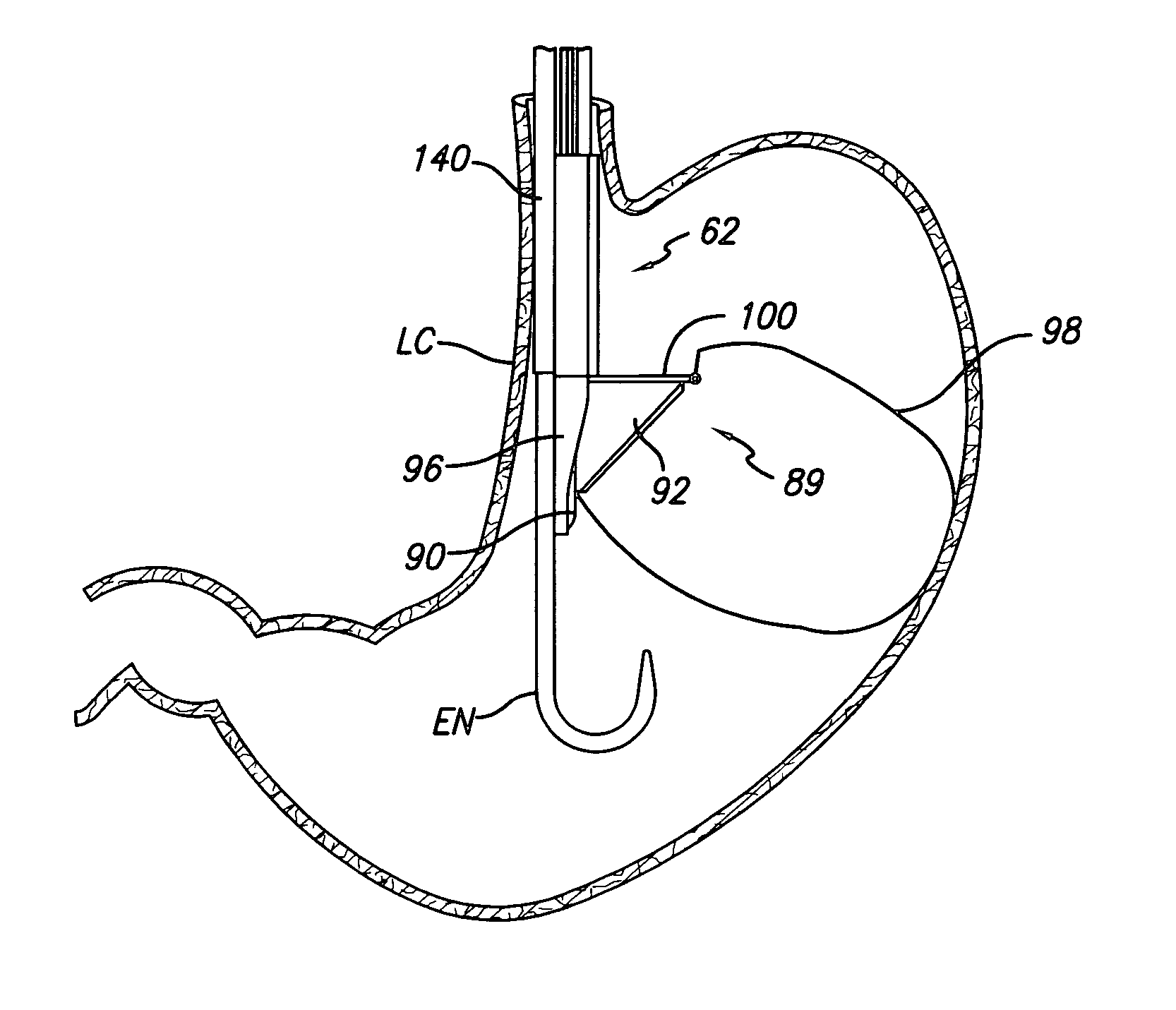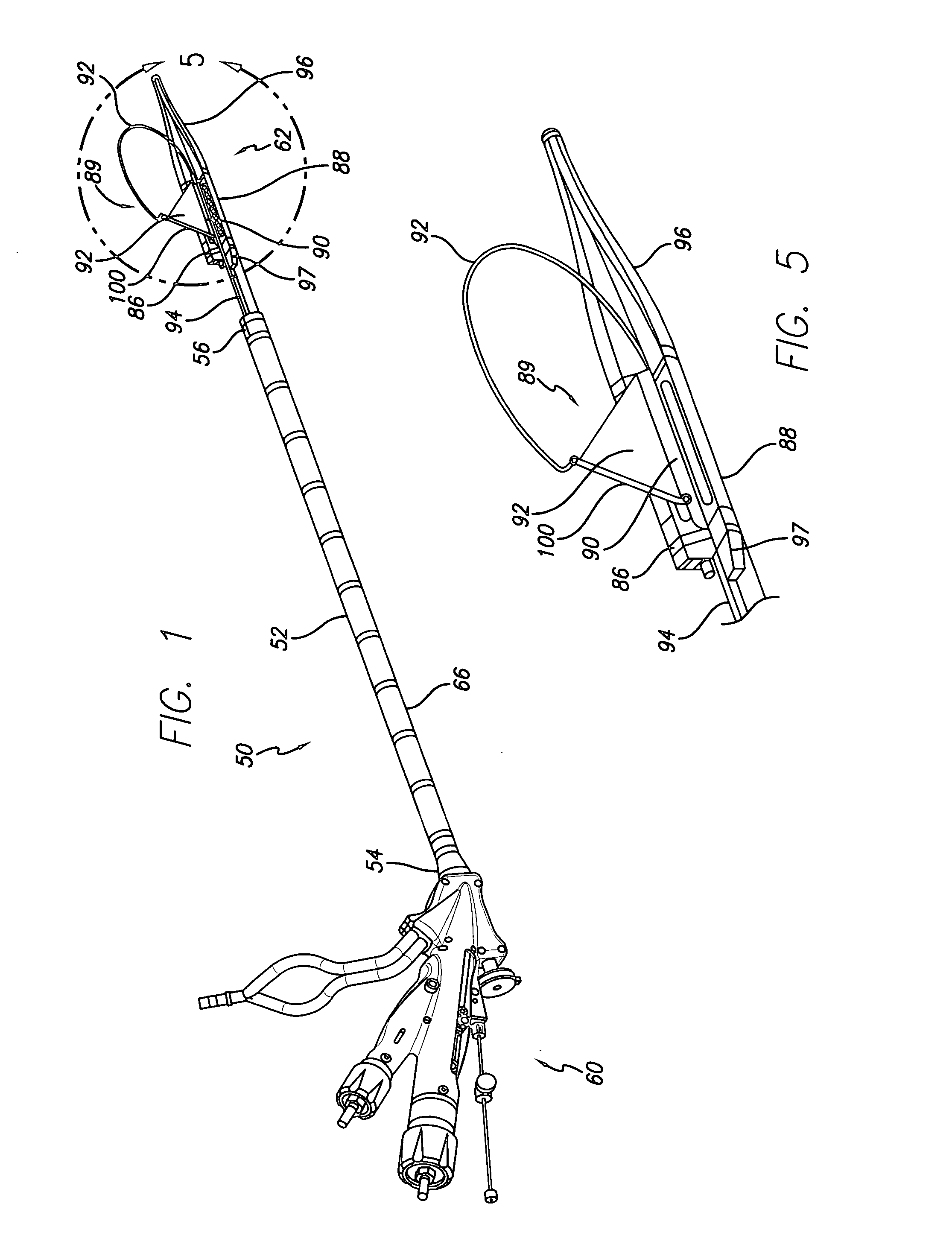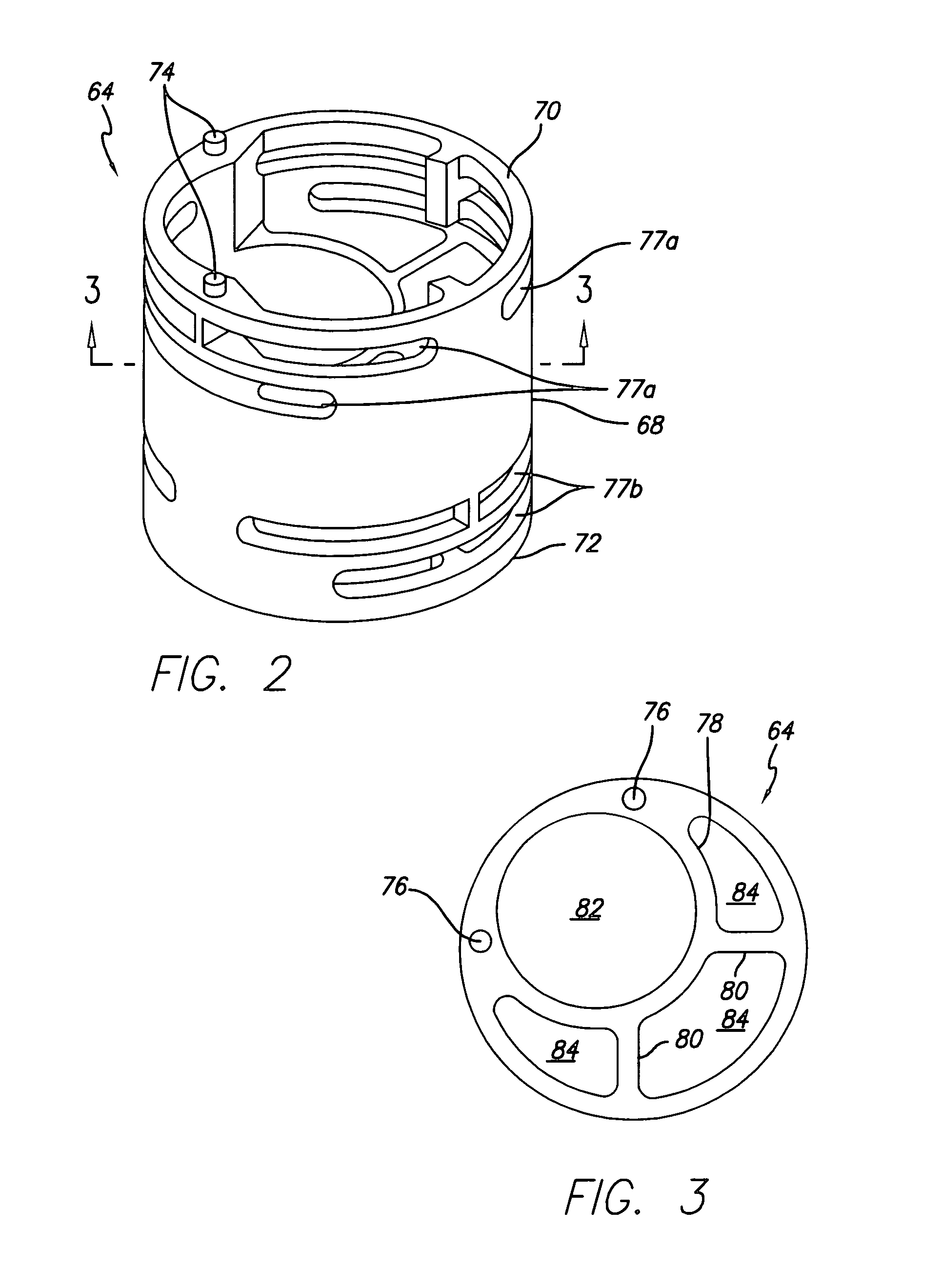[0013] A
handle may be located at a proximal end of an elongate body or member and used to manipulate the device advanced within the hollow body organ as well as control the opening and closing / clamping of the acquisition members onto the tissue. The elongate body may include a series of links, or be formed from an
extrusion fabricated with one or more various lumens to accommodate the various control mechanisms of the acquisition device. Similarly, the control mechanisms may be grouped together and sheathed in a thin
skin sheath, such as a heat shrink or spirally wound
adhesive backed tape. A working lumen may extend entirely through the elongate member and may be sized to provide access to the distal end for various surgical tools, such as an
endoscope or other
visualization device, and / or
therapeutic devices such as snares, excisional tools,
biopsy tools, etc. once the distal end of the
assembly is positioned within the hollow body organ. The acquisition members may be joined to the elongate body via a passive or active hinge member, adaptable to position the
assembly. The acquisition members may generally include a cartridge member placed longitudinally in
apposition to an anvil member. The cartridge member may contain one or several fasteners, e.g., staples, clips, anchors, etc., which may be actuated via controls located proximally on the
handle assembly. Moreover, the septum or tissue barrier may be removably positioned between the cartridge member and anvil member and used to minimize or eliminate cross acquisition of the tissue into the cartridge member and / or anvil member.
[0016] While the device is in a delivery configuration, the components of the distal working portion of the device (the cartridge member and anvil member) are disposed such that the cartridge and anvil are directly positioned into
apposition about the septum. Once desirably positioned, one or both of the cartridge member and anvil member may be rotated about a pivot or translationally moved in parallel to one another. Then, portions of the
stomach wall may be acquired by, or drawn within their respective openings. The configuration of the cartridge member and anvil member and the positioning of the device within the stomach are such that this
tissue acquisition procedure also enables the devices to be self-adjusting with respect to the acquired tissue. Alternatively, the cartridge and anvil members may close to within a fixed distance, i.e. a fixed distance clamp gap. Moreover, the device is configured such that portions of the stomach wall are automatically positioned for fixation upon being acquired and the tissue becomes automatically adjusted or tensioned around the perimeter of the distal working portion of the device in the stomach and within the distal working portion inner volume, to achieve the desired resulting geometry (e.g., small gastric pouch or restrictive partition or baffle). Because of the manner in which the tissue is acquired, the tissue intimately surrounds the cartridge member and anvil member to define or calibrate the subsequent volume of the resulting
gastric lumen. Thus, the gastric volume may be somewhat controlled by adjusting the volume of the cartridge member and anvil member, or the use of accessory devices such as a scope or
balloon. As a result, once the desired volume is known and incorporated in the device, the user can achieve a controlled acquisition and without intraprocedural adjustments or positioning requirements.
[0017] The septum may act effectively as a barrier between the openings to facilitate the acquisition of the tissue to their respective openings while minimizing or eliminating cross acquisition of the tissue into the cartridge member and / or anvil member. In other alternatives, the septum may be omitted from the device and acquisition of the tissue may be accomplished by sequentially activating vacuum forces within the openings. Once the tissue has been acquired, the septum may be removed from between the cartridge member and anvil member by translating the septum distally or proximally of the cartridge member and anvil member or left within the stomach for later removal. Alternatively, the septum may rotate, collapse, be ejected up and out from between the jaws. In one alternative, the septum includes a sail that can be extended between the cartridge member and anvil member after being delivered to the stomach, and then collapsible between the cartridge member and anvil member for removal from the stomach.
[0018] The cartridge member of the tissue treatment device may be re-loadable with a removable staple cartridge after forming a plication within the cavity. This allows the same tissue treatment device to form multiple plications within the cavity. A method of treating a stomach cavity may include forming a first plication within the stomach cavity using staples from a first removable staple cartridge, which is easily removed from the cartridge member. A second removable staple cartridge is then inserted into the cartridge member, and a second plication is formed within the stomach cavity using staples from the second removable staple cartridge.
[0019] Another method of forming a plication within the stomach cavity may include clamping the cartridge member and the anvil member together and then reevaluating the folds of tissue acquired before firing staples into acquired tissue. This method helps to ensure that the desired tissue is acquired by the tissue treatment device, and that there are no folds or pleats present in the acquired tissue. After inserting the tissue treatment device transorally to the stomach cavity, stomach tissue is acquired at a target region for treatment with the tissue treatment device. The cartridge member and anvil member of the tissue treatment device are then clamped together grasping the acquired
target tissue, and the stomach cavity can be insufflated to inspect the acquired
target tissue with an
endoscope. If the inspection reveals that the tissue acquired is not the targeted tissue or that there are folds or pleats within the acquired tissue, the acquired tissue can be released from the tissue treatment device and re-acquired. If the inspection reveals the acquired tissue would form a desired sleeve, then the stomach cavity can be desufflated once again, and the cartridge member and the anvil member may be unclamped into an open configuration, to fully acquire the tissue. The tissue treatment device may include a barrier such as a septum, in which case the barrier would be moveable between the cartridge and anvil member to control the length of tissue secured, or removed from between the cartridge member and the anvil member to fasten the full length of the cartridge and anvil working surface. After which, the cartridge member and anvil member are clamped together and the stomach cavity is again insufflated to inspect the acquired tissue. If the inspection reveals a desired formation between the folds of acquired tissue, the cartridge member and anvil member are fully clamped together and the acquired tissue is plicated to form a gastric sleeve within the stomach cavity and the GEJ.
[0021] A
system for reducing the volume of the stomach cavity may include the tissue treatment device for forming a plication at least partially within the stomach cavity and a restrictor device to further
restrict the stomach cavity. When forming a sleeve along the lesser curve of the stomach with the tissue treatment device, the restrictor device may be used to acquire tissue between an anvil member and a cartridge member to form a
single fold plication within the sleeve. The restrictor device may have a vacuum pod located between the anvil and cartridge member to acquire the desired tissue. A distal outlet of the sleeve can be reduced by placing a plication with the restrictor device near the distal outlet. Further, the tissue treatment device may form multiple continuous plications within the stomach cavity. In the event that unwanted stomas are form between the multiple plications, the restrictor device can be used to close those unwanted stomas.
 Login to View More
Login to View More 


